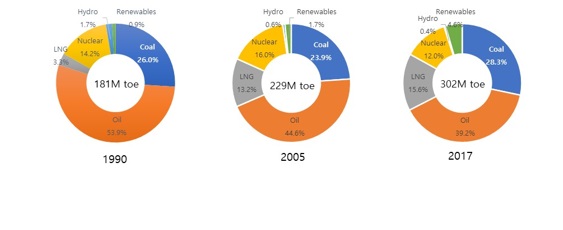CHUNG WOO-JIN AND LEE TAE EUI
MAY 23, 2021
I. INTRODUCTION
In this Special Report, Chung Woo-jin and Lee Tae Eui, describe the recent history and current status of energy supply and demand in the Republic of Korea (ROK), provide an overview of ROK energy policies, describe ROK involvement in discussions regarding regional energy cooperation, and present and evaluate a set of future scenarios for evolution of the ROK energy sector focusing on the use of renewable and nuclear energy in the electricity sector. Some of the potential short- and longer-term impacts of the COVID-19 pandemic on the ROK energy system are also noted.
A summary of this report follows. A downloadable PDF file (1.9 MB) of the full report is here.
Chung Woo-jin, is a Senior Fellow at the Korea Development Cooperation Institute, and Lee Tae Eui is a Research Fellow at the Korea Energy Economics Institute.
This report was produced for the Regional Energy Security (RES) Project funded by the John D. and Catherine T. MacArthur Foundation and includes material presented at the RES Working Group Meeting, Tuushin Best Western Premier Hotel, Ulaanbaatar, Mongolia, December 9-11, 2019.
The views expressed in this report do not necessarily reflect the official policy or position of the Nautilus Institute. Readers should note that Nautilus seeks a diversity of views and opinions on significant topics in order to identify common ground.
This report is published under a 4.0 International Creative Commons License the terms of which are found here.
Banner image: ROK primary energy consumption by source (prepared by the authors based on data from Korea Energy Economics Institute (KEEI, 2019).
II. NAPSNET SPECIAL REPORT BY CHUNG WOO-JIN AND LEE TAE EUI
ROK ENERGY SECTOR AND ROK ENERGY POLICIES, UPDATE AND RESULTS OF THE ROK ENERGY PATHS MODELLING EFFORTS
CHUNG WOO-JIN AND LEE TAE EUI
MAY 23, 2021
Summary
With environmental issues increasing in importance, the current government of the Republic of Korea (ROK) is strongly pursuing energy transition policies to phase out nuclear power and to substantially reduce the use of coal-fired power generation while increasing the use renewable energy and natural gas. Many plans for energy transition measures, programs, and policies have been established and carried out by the government. The energy transition policy, however, is facing strong resistance from many opinion groups including a number of energy experts. It is therefore, not certain that the current energy transition policy will be realized in the coming decades, particularly if the political landscape changes in the future.
For the ROK Working Group’s analysis of ROK energy futures using the LEAP (Low Emissions Analysis Platform—formerly Long-range Energy Alternatives Planning) model, five scenarios of ROK energy demand and supply were designed by combining different measures in the three major energy policy areas of nuclear energy, renewable energy, and regional cooperation. The LEAP model analysis indicates that one of the most positive energy policy scenarios for ROK greenhouse gas reduction was the continuing operation nuclear power generation. The use of nuclear power, however, should be reduced because of its own risks, and as a result of replacing nuclear power with fossil-fueled electricity generation, greenhouse gas emissions can increase. These are political issues that the ROK government must resolve. It appears that a significant amount of greenhouse gas reduction is also possible by importing electricity through regional cooperation schemes if the imported power is carbon-free.
1 Introduction
The major initial spur of the Republic of Korea’s (ROK’s) post-war economic development was the launching of the ROK’s first five-year economic development plan in 1962. The policy measures included in the plan were designed to increase the country’s wealth through the export-oriented industrialization under strong government leadership. These plans have been implemented every five years through the completion of the seventh economic development plan in 1996. During the implementing periods of the economic development plans, the ROK grew from one of the poorest countries in the world to an OECD member country, and was transformed from an agricultural economy to one of the world’s major manufacturers. Since the first economic development plan was implemented, energy security (defined as stable energy supplies) and energy efficiency (energy savings) have been the main pillars in the energy policies of the ROK because the country has very limited energy sources and consequently depends on meeting most of its energy demand with resources imported from overseas countries.
In 1997, the ROK experienced a financial crisis in which many companies went bankrupt, with the failed firms holding more than 400% of their capital in debt on average. During that period, almost all of the ROK’s companies had the burden of massive debts incurred in securing the investment capital required to increase production to meet rapidly increasing demand for goods and services experienced as a result of (and causing) high economic growth rates. Since then, the ROK economy has pursued a policy of “robust growth” rather than rapid growth. In energy policy, environmental protection and reducing greenhouse gas (GHG) emissions became a new policy pillar in addition to energy security and energy efficiency as climate change has emerged as an international issue. The ROK, which ranked 9th worldwide in per-country GHG emissions as of 1997 (and ranked 7th as of 2018, based on IEA data), should have prepared various measures to restrict the use of fossil fuels. In that sense, nuclear power played a key role in meeting increasing energy demand while reducing GHG emissions. Nuclear power was also an important alternative energy source for alleviating the import costs of fossil energy because the ROK depended (and still depends) almost entirely on fuels imported from overseas countries. Since the ROK constructed its first nuclear power plant in 1978 using technology and equipment from the United States, the country has worked to develop and acquire its own nuclear power technology manufacturing capabilities, ultimately becoming the world’s 5th largest nuclear power nation (by generation capacity) built largely with ROK technology. The ROK completed an agreement to export its first nuclear power reactors to the United Arab Emirates in 2015 and is currently constructing four 1400 MW reactors developed in the ROK there. The ROK is also participating in bidding to construct nuclear power plants in several countries, including the United Kingdom.
The new ROK government that took office in May 2017, however, announced the phase-out of domestic nuclear power over the next 40 years. President Moon Jae-in’s administration has emphasized that the country is in an unsafe condition because there are too many reactors in a relatively small area, as the ROK is ranked number one in the world in terms of nuclear power density (nuclear power installation capacity divided by national land area). The government, on the other hand, has focused on renewable energy as the key alternative to meet the ROK’s increasing energy demand as well as to reduce GHG emissions, and has proclaimed an energy transition policy to increase the shares of renewable energy and natural gas and decrease those of nuclear and coal-fired power. In the case of coal, the government also regards coal-fired power as one of the core PM2.5 (particulate matter of less than 2.5 microns, which is a health risk) emission sources in the ROK.
As a result of the Moon administration’s policies, plans to build new nuclear power plants were canceled, and the older coal-fired power plants were decommissioned earlier than the licensed life spans. Some of the plans to build new coal-fired power plants were transformed into plans to construct LNG (liquefied natural gas)-fueled power plants. A far-reaching scheme to expand the supply of renewable energy was established in the Moon administration. But this ambitious energy transition policy has been embroiled in political and social conflicts. The opponents of the scheme insist the energy transition policy could endanger the ROK’s energy supply and raise energy prices as the dependency on the technically uncertain renewable energy and expensive natural gas will rise, while reducing electric generation from nuclear and coal-fired power plants that are stable and cheap sources of electricity.
This report explores the structural changes in ROK energy supply and demand over the years and the current controversial energy policies in the ROK, and projects a set of scenarios for the ROK’s future long-term energy supply and demand using the LEAP (Low Emissions Analysis Platform, formerly the Long-range Energy Alternatives Planning system) software tool.[1] The scenarios explored here focus on ROK nuclear power policies. The ROK’s policies and plans for electricity grid connections with Northeast Asian countries are also introduced, and the impacts of grid interconnection on the ROK’s energy supply situation are analyzed with the LEAP model.
5. The Impacts of Covid-19 on the ROK’s Energy System
5.1 The Covid-19 Situation and Social Distancing Rules
1. Outbreak Timeline
The ROK was one of the first countries outside of China to experience a COVID-19 infection, with the first case identified as a Chinese woman who came from Wuhan, and reported on January 20, 2020. The first Korean national to be infected was reported three days later, a person who worked in Wuhan and returned to the ROK with flu symptoms. The government established an emergency response committee within days of the first cases becoming known and controlled the spread of the virus relatively well for the first month of the outbreak. The number of confirmed cases ranged from zero to two per day and the cases were mainly found in Seoul and its neighboring area until a cluster of infections was identified in Daegu, a city of 2.5 million, located in south-eastern Korea about 200 km from Seoul. The cluster, which first appeared as 20 cases on February 19, was tied to religious events held at the Shincheonji Church of Jesus, at which multi-day events that involved more than 10 thousand church members were held. One of the members who had symptoms and later was confirmed to have the virus (dubbed patient No. 31) had participated in the events after her diagnosis. The gatherings triggered a drastic escalation of the spread of COVID-19 throughout the country because the religious events were typically held with people in a very close proximity and included physical contact of the members of the gathering in an indoor space. Just three days after the cluster was identified, the number of new confirmed cases jumped to 229 and thereafter daily confirmed cases rose rapidly and reached a peak of 813 on February 29, which made the ROK the second most infected country in the world after China by early March.
The government designated Daegu City as “a Special Management Zone” and the Prime Minister took direct control of measures to restrict the spread of infection in the city. Residents were advised to stay home and minimize movement outdoors for weeks. But the city was not locked down and almost all stores remained open. Figure 5‑1 shows the timeline of COVID-19 outbreaks in the ROK through September 2020.
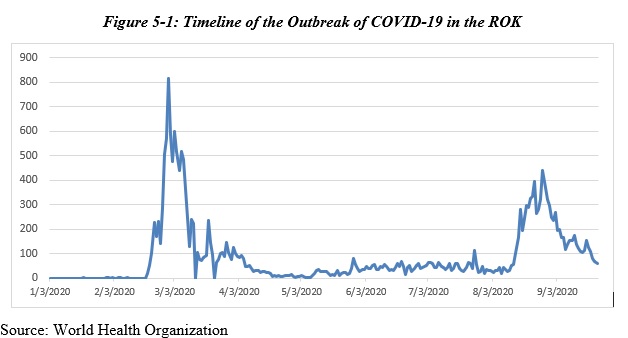
Thanks to the efforts of central and local governments and resident’s cooperation, the number of daily confirmed cases steadily declined to nearly below 100 one month after the peak. Thereafter, daily new cases were kept near 50 until August 15, although there was a minor resurgence in mid-May when the government relaxed social distancing rules and new clusters tied with attendance at nightclubs emerged.
A large-scale anti-government protest led by far-right groups took place illegally on August 15, 2020. This movement, during which the protesters included many people wearing no masks, gathered in downtown Seoul, and triggered again an escalation of the spread COVID-19 in the ROK. The infection spread rapidly nationwide because at that time, the protesters came from many local places as well as from the Seoul area, and brought the virus back to their home communities when the protest ended. This created a situation in which it was more difficult to prevent a spreading of COVID-19 than it was to manage the first cluster that occurred in Daegu on February 19. The number of new daily confirmed cases jumped again to about 200 on August 20 and continued to rise to a peak of 441 on August 27. The government strengthened social distancing rules to the level 2.5 in which 12 types of crowded businesses, including coffeehouses like Starbucks, health clubs, and private cram schools, were ordered to be shut down, and one-third of all employees in the government, state-run agencies and public institutions were required to work from home. By application of strong policies to restrict the spread of the virus, the number of new COVID-19 cases fell to about 100 by one month later. The social distancing rule at level 2.5 was implemented for two weeks and then eased to level 2.0. As of September 20, the number of cumulative cases of COVID-19 was 22,975 and the cumulative number of deaths was 383 in the ROK. The number of daily new cases was about 60~120 between September 20 and 25. The level 2 of distancing rule is still being implemented as of this writing, a rule under which indoor gathering of more than 50 people are banned along with outdoor gathering of more than 100 people.
2. Social distancing rules
As the first cluster of COVID-19 occurred in Daegu, the government began to implement strong social distancing campaigns to contain the spreading of the disease. Facilities were required to conduct temperature checks for fever at entry points and in offices, public and multi-purpose facilities were temporarily shut down, and schools and universities were closed, with only on-line classes permitted. Visa waivers were suspended and all of the people entering the ROK were required to comply with a 14-day quarantine protocol. The ROK adopted a three-level policy of social distancing rules triggered by thresholds in the number of daily confirmed COVID-19 cases nationally (level-1: less than 50 cases, level-2: 50-100 cases, and level-3: exceeding 100 daily cases for 14 straight days). Under level-1, ordinary economic, social activities are allowed to proceed but mandatory mask-wearing and electronic visitor logs are required for high-risk businesses. Under level 2, the 11 categories of high-risk facilities would be required to suspend all operations, including bars, karaoke rooms, and large after-school academies. Moderate-risk facilities such as religious establishments, movie theaters, wedding halls, and public baths are required to adhere to disease prevention rules. Under Level 3, all schools and kindergartens are required to implement online classes or shut down completely. All gatherings of 10 or more people would be prohibited apart from attendance of family funerals or essential public and business activities.
While the government introduced enhanced physical distancing so as to prevent diffusion of the virus, the ROK did not introduce a full lockdown on any city or region. The authorities recommended the temporary suspension of the operation of religious meetings, as well as indoors sports and entertainment facilities, and also urged citizens to stay at home and work remotely.
5. 2 Impacts of Covid-19 on the ROK Economy
Covid-19 triggered a deep recession in the ROK, just as it has in many other countries worldwide. According to recent statistics from the Korea Development Institute (KDI) ,[2] GDP fell 1.3%, and 3.2% respectively in the first and second quarters of 2020 (measured quarter on quarter). Exports dropped 1.4% and 16.6%, and imports declined 3.6% and 6.7% in the first and second quarters (q-o-q). On the production sides, the situation has worsened in the second quarter of 2020. Output in the agriculture, forestry, and fisheries sector dropped 9.5 percent compared to the previous quarter, and manufacturing fell 8.9 percent due to weak production (and purchases) of transportation equipment, computers, electronic products, and optical products. Construction contracted 0.3 percent as building construction declined. Services fell 0.9 percent as wholesale and retail and hotels and restaurants activity declined, with additional declines in transportation, entertainment and leisure services, and other services.
Private consumption fell 6.5% in the first quarter but rose 1.5% in the second quarter due to large scale government distribution of coronavirus relief funds to all Korean people during April, 2020. The number of people employed also declined 1.5% and 1.3% in the first and second quarters of 2020, respectively. Table 5‑1 compares selected quarterly ROK economic statistics for 2018, 2019, and the first two quarters of 2020.
The ROK economy has been sharply shrunk by the COVID-19 pandemic, but the country was able to avoid the extensive lockdowns endured by many other countries. This has limited the damage to the domestic economy and output has contracted less in the ROK than in other OECD countries. But as the ROK economy is heavily dependent on global business, both exports and imports, it could be damaged more than the economies of other countries if the worldwide recession caused by the pandemic persists for a long time.
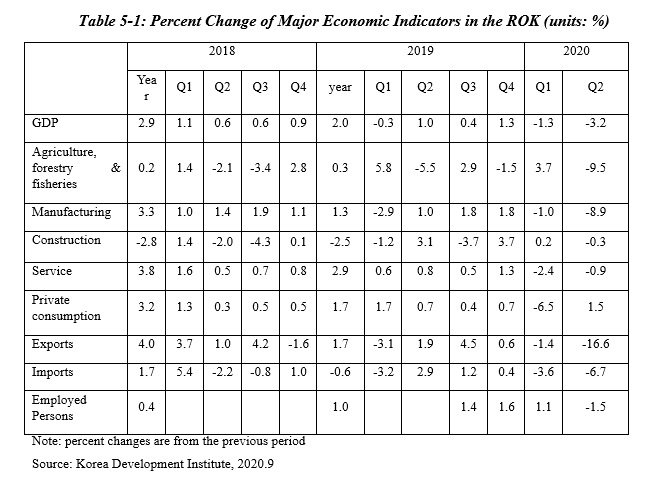
5.3 Covid-19 Impacts on Energy Systems in the ROK
1. Changes in Energy Consumption Due to the Pandemic
As the economy was hit hard by COVID-19, the ROK energy market also contracted significantly. Primary energy consumption in the first half of 2020 fell by 3.8% compared to the same period of 2019. Final energy consumption showed the same trend, falling by 3.6% relative to 2019. The decline of energy consumption in the ROK experienced in 2020 was the first for the country, except for a slight decline in 2019, since the financial crisis in 1998 (see Figure 5‑2). In 2019, though the ROK economy grew by 2%, energy consumption slightly decreased due to recession in the heavy energy consumption industries such as the petrochemical and steel sectors. Most other industries expanded their energy use in 2019, but all of the ROK’s industrial subsectors showed a reduction in their energy consumption in the first half of 2020 due to COVID-19 and the measures applied to contain the pandemic.
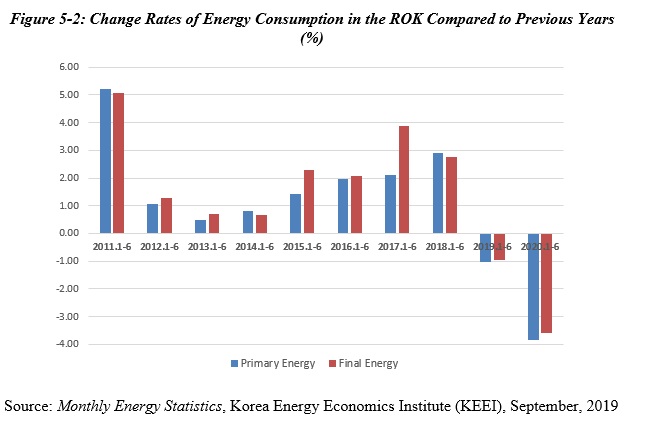
Among energy forms, the ROK’s consumption of fossil energy decreased in 2020, but on the other hand the use of hydro, nuclear, and renewable energy increased. Among the fossil fuels, the rate of decline of coal use was the steepest (about 12%), and those of oil and LNG were less, with both falling 3-4 percent in the first half of 2020 relative to the same period in 2019 (see Figure 5‑3). Though the consumption of renewable energy increased in the first half of 2020, the growth rate (3.5%) was quite low compared to growth in previous years. The annual average growth rate of renewable energy use between 2010 and 2019 was 13.08% in the ROK. Despite the restriction policies, the consumption of nuclear energy increased because the average capacity factors of nuclear plants in the previous two years were poor as a result of frequent problems at the facilities. Hydro energy accounts for less than 1% of total ROK electricity supplies, and its availability and use depend on the weather in the ROK.
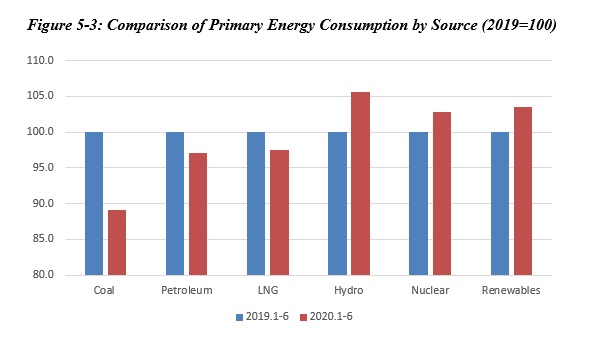
Total ROK final energy consumption declined in the first half of 2020, as did consumption of each type of fuel. Among the fuels, the decrease in the rate of coal consumption was the highest, due to the decline in industrial output, followed by the decline in the use of city gas. Coal as a secondary energy source is usually used only in the industrial sector. The consumption of city gas fell significantly due to in part to sluggish business in the restaurants sector. Although the use of renewable energy sources in primary energy increased in 2020, the consumption of the renewable fuels in final energy demand sectors decreased, though its rate of decrease rate was the lowest among the different energy sources (see Figure 5‑4).
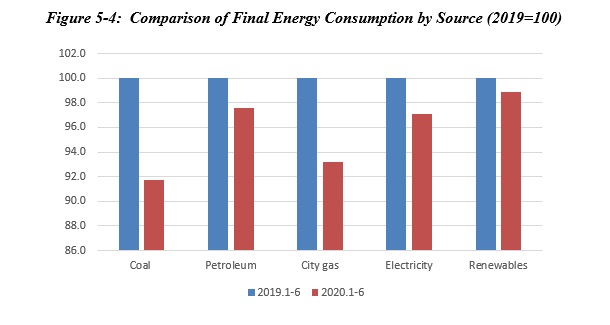
Energy consumption in all of the demand sectors decreased during the first half of 2020. Among them, the rate of decline for the transport sector was the largest (-10.6%), showing wide gaps relative to declines in other sectors. Energy consumption in the residential & commercial (R&C) and public sectors showed a relatively small declines when comparing with the industry and transport sectors (Figure 5‑5).
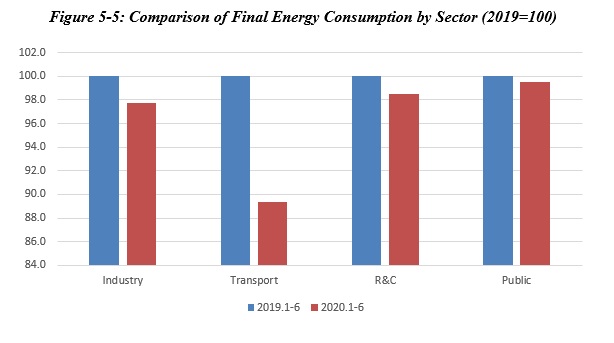
Although energy consumption declined in nearly all ROK economic sectors in the first half of 2020, electricity use in the residential sector sharply increased by 5.1% for the first half of this year because many people stayed home in order to avoid the pandemic. On the other hand, electricity consumption in the commercial sector decreased by 2.1% in the same period. In the case of city gas, consumption in the commercial sector significantly decreased (by 13.3%) because people reduced their use of restaurants and coffee houses in order to comply with social distancing rules. The consumption of city gas in the residential sector also slightly decreased in the first half of this year when compared with the same period, last year, but has increased by 4% between March and June of 2020, even though the March-to-June period normally sees a decline in energy demand for heating. The increase in city gas use from March to June in the second quarter of 2020 reflects the increased use of city gas for cooking in 2020 due to peoples’ increased time at home relative to 2019. In the industry sector, the consumption of petroleum increased by 2.4% in the first half of 2020, despite the decrease in all other forms of energy consumption in the sector. It seems that the petrochemical business, which accounts for 95% of industrial oil demand in the ROK, increased its production to take advantage of low international oil prices. Table 5‑2 shows monthly consumption of city gas and electricity in the residential sector for the first half of 2019 and 2020.
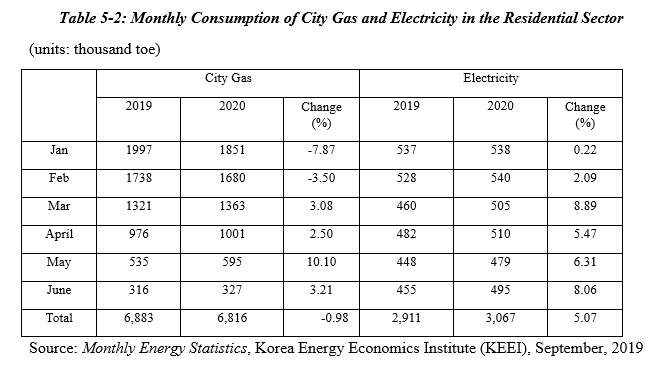
During the outbreak of COVID-19 in the ROK, trends in renewable energy demand were notable. In particular, power generation from renewable energy sources in the first half of 2020 declined (-2.5%) for the first time since renewable energy statistics in the ROK power sector were first published (in 2004). This also contrasts with the approximately 10-fold increase in renewable generation over the past 10 years through 2019. Although the generation capacity of renewable energy systems increased in the first half of 2020 year, the state electricity wholesaler (KEPCO) reduced purchases of renewable generation because electricity consumption fell during the spread of the pandemic. The SMPs (System Marginal Prices) for power generation in the power exchange market also fell significantly because international prices for fossil fuels fell, together with the decreasing consumption of electricity. According to the electric power statistics information system in the Korea Power Exchange (KPX), the SMP in the first six months of 2020 declined by 20.5% from the same periods in 2019. With the falling SMPs, the generation price for photovoltaic and wind power generations in the first half of 2020 fell by 20.9% and 22.9%, respectively, from the same period of 2019, while the average price of total power generation decreased by just 8.6% (see Figure 5‑6). This implies that the impact of COVID-19 on renewable energy sources was stronger than the impact on fossil energy-fueled power sources in the electricity generation sector in the ROK. Low prices received for renewable power generation would reduce the revenues of renewable generation businesses and will likely slow investment in renewable generation facilities.
The consumption of renewable energy in the industrial sector also declined after COVID-19 arose, but renewable energy consumption in the residential and commercial and public sectors slightly increased, but those sectors together account for just a small portion (about 10%) of total renewable energy demand.
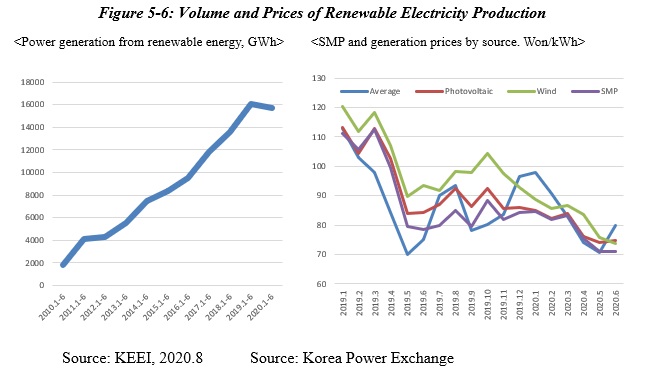
2. Projections of Future Changes in ROK Energy System due to COVID-19
If the COVID-19 pandemic continues until the second half of next year or beyond and Korea’s economy suffers a prolonged downturn, ROK energy consumption is expected to decrease further. In particular, energy demand in the transport sector will decline much more if there is a long period of social distancing campaigns. Sluggish industrial activity would also decrease electricity demand, but the demand for electricity and city gas will increase in the household sector as telecommuting can be expected to proliferate even more than in 2020.
Reductions in demand for renewable energy could be intensified if fossil energy prices continue to be low and if generation dispatch policies remain as they are. If electricity demand decreases further due to a continued economic recession, concerns about the flexibility of the ROK power system will grow. As power generation from variable renewable energy (VRE) sources such as solar PV and wind begin to increase on a large scale over the next few years in the ROK, the flexibility issue in the power system will begin to become more important due to the intermittency, variability, and uncertainty of VRE. This issue has already appeared this year in Jeju, the ROK’s largest island and a famous tourist destination. Renewable power accounts for 35% of generation on the island, and as electricity consumption on Jeju has decreased due to the sharp decrease of tourist activity caused by the COVID-19 pandemic, the number of VRE curtailments in the island’s power system has rapidly increased.
A few VRE curtailments in the ROK occurred several years ago due to the increase of renewable generation capacity, but the curtailment problem has become more serious during 2020 since the coronavirus outbreak. There are ways to secure additional flexibility in the power system, such as transmission links to countries outside the ROK and implementation of energy storage technology (EES), but because the country is in effect an energy island, transmission to other countries is not a possible alternative (at least in the short term), and power storage technologies are still expensive and it is not certain whether they can be safely integrated into the ROK electricity system—a concern resulting from several fires that have already occurred at battery energy storage facilities in the ROK—although global experience with EES technologies is growing rapidly. If the outbreak of COVID-19 continues for a long time and ROK electricity demand decreases further, the VRE curtailment problem is expected to worsen, which could curb investment in renewable energy. This will have a negative impact on the current government’s policy to expand renewable energy use.
If the COVID-19 pandemic ends, the prices of oil and other fossil energy are expected to rise significantly in the short term because oil supplies would initially be tightened by the decreased investment in oil production during the period of the pandemic. With the rising price of fossil energy, investment in renewable energy would be expected to be revitalized. As electricity demand increases, the problem of VRE curtailment is expected to be alleviated.
In the mid to long term, fossil energy demand will shrink, as nations worldwide work to reduced GHG emissions, and prices will fall. Low fossil energy prices, however, likely will not significantly frustrate the expansion of renewable energy due to the increasingly serious impacts of climate change, and the increasing deployment of GHG emissions mitigation measures by the international community to address climate change. In addition, the outbreak of the virus reminds people of the importance of the environment, which could help to sway public opinion in favor of pushing ahead with renewable energy expansion policies. However, in the ROK, as well as in other countries, if problems related to VRE curtailment caused by the volatility of renewable energy generation are not resolved by technology development and/or the implementation of policies to strengthen the flexibility of the power system, investment in renewable energy is likely to shrink.
The experience with COVID-19 has changed the modes of operation of some businesses within the ROK economy, just as it has changed the lives of the ROK people. Delivery service businesses have been greatly expanded since the outbreak of COVID-19, but on the other hand, businesses like department stores and restaurants where many people gather have experienced significant declines in sales. Video meetings and conferences where people do not gather have also significantly increased. The changes in business types and living culture brought on by adaptation to COVID-19 isolation measures are likely to continue even after the pandemic ends. The experience of working from home during the outbreak of COVID-19 will influence the further expansion of the flexible working hours policies in many companies even after the coronavirus pandemic has subsided. In the long-term, this will cause electricity demand to decrease in the commercial and building sectors, but to increase in the residential sector. Prospects for city gas demand in the commercial sector post-COVID-19 remains uncertain. The restaurant business will likely shrink as it transitions to expanding food delivery, rather than eat-in dining, which will become a factor in decrease the demand for city gas for cooking. But if people reduce cooking at home and expand food delivery, city gas demand in the commercial sector may increase due to the expansion of “factory cooking”.
In the ROK, energy security concerns have mainly focused on external markets for fuels because the country has historically imported more than 95% of its energy requirements. Traditional policies for energy security have been oil stockpiling, overseas resource development, and diversification of energy import sources, policies that are designed to alleviate external energy risks to the ROK. During the period of the pandemic, however, external energy risks are significantly reduced as oil and oil products are in oversupply and as fossil energy prices in general have fallen sharply. On the other hand, risks related to ROK electricity infrastructures have rapidly emerged as the power capacities of variable renewable electricity sources have increased while electricity demand has declined. This situation force a transformation in the focus of energy security policies in the ROK from traditional measures for management of energy imports supply and price risks to new measures to manage internal risks. As a result, policies such as oil stockpiling, overseas resource development, and diversification of energy imports among supplier countries are expected to be less predominant in the ROK over time, in part due to the COVID-19 experience.
8. Conclusions
The ROK’s energy policy stands at a crossroads. Korea is facing a policy issues associated with its planned energy transition. A shift from an emphasis on economic growth, which has been at the center of energy policy formulation in the ROK thus far, to an energy policy that considers the environment and safety, is gradually appearing. The current administration (as of 2020) is trying to reduce the ROK’s use of nuclear power, which has played an important role in energy security policy over the last several decades, and to build an energy mix in the future, focusing on renewable energy that does not generate carbon emissions. Recently, as the problem of fine dust has emerged, voices have been raised about the need to phase out coal-fired power plants, which are the major source of fine dust in the power generation sector.
In this process, a conflict between an ideology of reducing nuclear and coal generation with the reality of the current status of the ROK’s energy sector arises, as do considerations of the impact of potentially higher energy prices on what is already slowing economic growth. The expansion of renewable energy promoted by the government may not occur as expected due to problems such as civil complaints about siting new and renewable energy facilities. Even if the supply of renewable energy is expanded, there remains a problem to be solved: the operation of a stable power system as the use of intermittent generation resources rapidly increases.
Although the energy transition is being carried out to convert the ROK to a low-carbon economy, in some ways the transition may actually exacerbate the problem of greenhouse gas emissions. Expanding nuclear power has long been a significant tool favored by ROK policymakers to reduce greenhouse gas emissions in Korea. Generation powered by renewable energy also does not emit GHGs. Even if renewable energy use increases, however, the nuclear reactor decommissioning policy that is part of the current energy transition plan may increase total domestic greenhouse gas emissions. That is because the use of power generation sources that emit greenhouse gases such as natural gas will need to increase due to the low capacity factors that are associated with intermittent sources of renewable energy such as wind and solar.
III. ENDNOTES
[1] See, Heaps, C.G., 2020. LEAP: The Low Emissions Analysis Platform. [Software version: 2020.1.19] Stockholm Environment Institute. Somerville, MA, USA. https://leap.sei.org.
[2] Korea Development Institute (KDI, 2020), “Economic News Briefing”, ROK Economic Bulletin, vol 4 No.9, 2020.9
III. NAUTILUS INVITES YOUR RESPONSE
The Nautilus Asia Peace and Security Network invites your responses to this report. Please send responses to: nautilus@nautilus.org. Responses will be considered for redistribution to the network only if they include the author’s name, affiliation, and explicit consent


